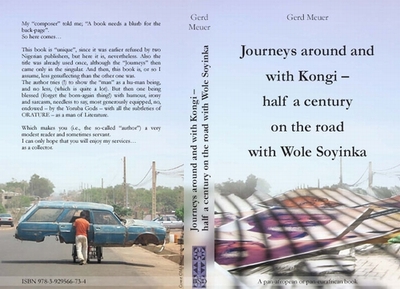da bookyou can order this unique book with the author for E 12,90 ('only') - Contact

My ‚composer’ told me:
“A book needs a blurb for the back-page.”
So here comes…
This book is ‚unique’, since it was earlier refused by two Nigerian publishers, but here it is, nevertheless. Also the title was already used once, although the ‘Journeys’ then came only in the singular. And then, this book is, or so I assume, less genuflecting than the other one was. The author tries (!) to show the ‘man’ as a hu-‘man’ being,and no less, (which is quite a lot.) But then one being blessed (forget the born-again thing!) with humour, ironyand sarcasm, needless to say, most generously equipped,no, endowed – by the Yoruba Gods – with all the subtleties of ORATURE. – as a man of Literature
Which makes you (i.e., the so-called ‘author’) a very modest reader and sometimes servant. I can only hope that you will enjoy my services… as a collector.
Book review by Temitayo Olofinlua:
Journeys Around and With Kongi By Gerd Meuer (231pp; Verlag Thomas Reche, Neumarkt (Germany))
This is the story of the Man, Wole Soyinka, as it has never been told before. It reveals that ‘Da Man' may not be as difficult as he seems, but rather is a down-to-earth personality that prepares food for others (p46), rides on ‘okada' commercial bikes (p58), (in this case, an interview with Julius Nyerere that never held; p93).
For good measure, he has also had days of cycling through Germany (p98). There have always been works revolving around the Man and his writings, but few have done more justice to ‘The Man in his elements' than Gerd Meuer's Journeys Around and With Kongi-half a century on the road with Wole Soyinka.
The book is a collection of experiences, memories, interviews, pictures, and believe it or not, emails between Kongi (Wole Soyinka) and the YoruBavarian (Gerd Meuer).
This is not the average book for so many reasons: its wit, sarcasm (that makes you laugh out loud), and the ‘appearance of truth' that pours out through each word in the book. With its use of short chapters and interactions between the writer, Soyinka and other people, Journeys Around With Soyinka is written in a style that makes it very easy to read.
It, however, turns out to be a mini-biography of the laureate and a mini-autobiography of the author over their 50 years of friendship, giving fascinating peeps into both lives... Meuer is indeed a collector of, not only emails or photographs, but memories and experiences, which makes this book a collector's item.
However, saying that this is a book on Meuer and Soyinka would be limiting the potentials of the book. It is also the story of Nigeria as it traversed many rivers of change, through independence, to the reign of ‘the boys in khaki'; it is also the story of a nation as it struggles at different times to find its identity-progressing and also reducing into woes.
It reveals the lives of other national figures by the side -the ‘UN-Wannabe-UN-boss'; the dictator, Sani Abacha, as a postmaster; and other secrets hidden in different parts of the book. The book gives insight into the involvement of Soyinka, the writer, as a fighter in the midst of these transformations. In a more subtle way, Meuer's book also records the role and development of African writing in the building of the continent.
Gerd Meuer has been Soyinka's ‘accompany', and friend since the so-called Penkelemes years, and he knows so much about the Man. As to what may lie behind the enigma that is Kongi, Meuer reveals quite a bit: Soyinka's love of red wine, his many wars with Olusegun Obasanjo (aka Baba Iyabo), his loyalty to Ogun the god of iron.
He also touches on Soyinka's many unsolicited ‘bodyguards', his love for ‘gallivanting' across many nations, and sometimes his inability to decipher cities. This book shows Soyinka as human by going through the veils that separate him from the crowd.
In fact, it is a demystification of some sort. Beyond this, the book shows that there can be brotherliness between two people that do not really have blood ties or national semblance. True friendship is built over time, Meuer suggests.
There are a number of unique qualities to Journeys Around With Soyinka. Unlike some writings on the subject, Meuer's book is penetrable and is not laden with so much ‘big-grammar'.
The writer makes use of pidgin English without apologies, as seen in ‘Like da Same one', ‘Da man is too Difficult', ‘When Da man ride ‘okada'; and though he tries too hard sometimes, it is a highly commendable effort, at least for a non-Nigerian.
I could not help but notice some errors interspersed on different pages of the book. Still, the reader will be awed by the many interesting things that the book contains. It also has this lack of order; the writer just relates the experiences in no particular order, which I suspect is deliberate.
One question for the writer: why is the book called a ‘pan-afropean or pan-eurafrican' book? Yes, the author is German, and yes, the book focuses on his many expeditions with Wole Soyinka-but why not let the book be just what it is -a book? Why is it shrouded in terms that seem to limit what it is?
All in all, it was good to read, and laugh too, as another writer does justice to the man behind the mask of the writer: Wole Soyinka.
http://www.234next.com/csp/cms/sites/Next/Home/5395645-147/story.csp |

